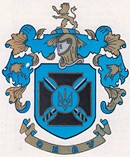Association of Ukrainian Former Combatants in Great Britain [Об’єднання бувших Вояків Українців у Великій Британії] – the largest association of Ukrainian ex-servicemen, mainly former soldiers of the Galicia Division, who settled in the United Kingdom in the 1940s.

The AUFC was formed on 30 July 1949 in London. The main aims of the organisation were to provide support to war invalids, preserve the memory of fallen soldiers, foster Ukrainian military traditions, and promote the idea of a free Ukraine. In the period to May 1958 about 5,800 Ukrainians, who had served in at least one Ukrainian or non-Ukrainian military formation during or before the Second World War, became members of the AUFC. Of these, 84% were former soldiers of the Galicia Division.
By 1958, however, many members had already emigrated from the UK, died, or otherwise ceased to be active in the organisation, leaving approximately 2,750 registered members. In the subsequent decades the membership continued to gradually decline, and in 1990 it stood at about 1,580. Members were organised into branches and informal groups, and in 1951 the organisation had 74 branches and 52 groups, of which most were in England and a small number in Scotland and Wales. In 1961 there were 38 branches and 20 groups, and in 1990 the respective numbers were 47 and 7. The branches and informal groups were divided into eight regions (six until 1963).
AUFC activities were organised by individual branches and on a regional or organisation-wide basis, and included talks on military matters, commemorations of historical anniversaries, informational campaigning, visiting Second World War burials of Ukrainian soldiers in war cemeteries in Austria and Italy, social events, etc. The organisation published several books of memoirs and literary works by its members, various pamphlets on historical and military topics, a wall map of the ethnographic composition of Galicia created by the geographer Volodymyr Kubijovyč (in the series of Proceedings of the Shevchenko Scientific Society), and, from 1955 to 1997, a journal entitled Surmach (The Bugler), which contained material on various topics relating to the organisation’s activities. The organisation also documented its history to 1990 in three digests of its activities (see Bibliography).
The AUFC was a member of the Ukrainian Ex-Servicemen’s Council, which was active from 1963 to the end of the 1970s as a platform for joint activities of various Ukrainian ex-servicemen’s organisations in Great Britain, and also of the Council of Ukrainian Ex-Servicemen’s Organisations, which brought together analogous organisations in various countries of the Ukrainian diaspora. After 1991 the AUFC established contacts in independent Ukraine, particularly with the Ukrainian Officers’ Union, and initiated the construction, in the village of Bazar, Zhytomyr oblast, of a monument, unveiled in August 2000, in memory of 359 soldiers of the UNR Army executed near the village by the Bolsheviks in 1921. The last general meeting of the AUFC took place in 2006, and in the early 2010s the organisation became inactive.
The AUFC was headed by: Mychajlo Dlaboha (1949-1953), Mychajlo Bilyj-Karpynec (1953-1973), Teodor Kudlyk (1974-1978), Bohdan Mykytyn (1978-1986), Swiatomyr Fostun (1986-2004), Marian Hajwa (acting head 2004-2006, head 2006-2011), Wolodymyr Jankiwskyj (acting head 2011-2015).
Bibliography
Almanakh ObVU, 1949-1964, ed. by T. I. Kudlyk (London)
Obiednannia buvshykh Voiakiv Ukraintsiv u Velykii Brytanii: Almanakh 2, 1964-1980, ed. by S. M. Fostun (London, 1980)
Obiednannia buvshykh Voiakiv Ukraintsiv u Velykii Brytanii: Almanakh 3, 1980-1990, ed. by S. M. Fostun (London, 1990)